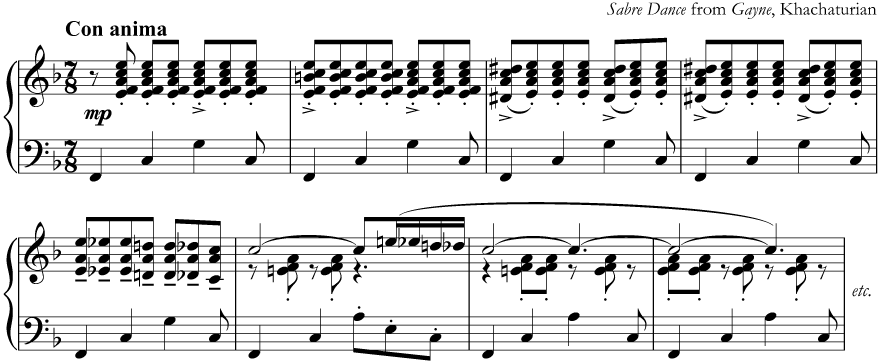Time signatures level 5
In this guide...
Key terms:
Subscription required!
To view the complete study guide, you will need a valid subscription. Why not subscribe now?
Already have a subscription? Make sure you login first!
Introduction
By now you will be familiar with both simple and compound time signatures. In the last in the series on time signatures, we will meet a third and final type: the irregular time signatures.
Regular time signatures
By now you should be familiar with all of the simple and compound time signatures, duple (such as 2/2 or 6/16), triple (such as 3/4 or 9/8), and quadruple (such as 4/2 or 12/8).
These time signatures are all called regular time signatures, because they have regular, repeated beat groups, in which each beat group and each beat is the same length.
Irregular time signatures
There exist, however time signatures that do not fit these regular patterns, and predictably these are called irregular time signatures.
The most common irregular time signatures are those in quintuple time and septuple time.
Quintuple time
As the name implies, quintuple time signatures have 5 beats to the bar, divided into beat groups of either
Two examples of quintuple time signatures are 5/4 (five crotchets to the bar) and 5/8 (five quavers to the bar).
Here is an example of some music in quintuple time - a famous tune called Take Five, for obvious reasons! Notice how the beat groups are uneven, quite unlike any music in a regular time signature such as 4/4:
 from Take Five, Paul Desmond
from Take Five, Paul DesmondQuick question
A quick question for you!
What key do you think the above example, from Take Five, is written in?
The answer's at the bottom of the page...
Septuple time
Rather less common than quintuple time is septuple time, in which as you can probably guess, the bars contain 7 beats. The beat groups can vary as there are several possible combinations, such as
Two examples of septuple time signatures are 7/4 (seven crotchets to the bar) and 7/8 (seven quavers to the bar).
The following music in 7/8 illustrates the very rhythmic nature of irregular time signatures:
 from the Sabre Dance from the ballet Gayne, Khachaturian
from the Sabre Dance from the ballet Gayne, KhachaturianAnother quick question
Here's another quick question for you!
What are the beat groups used in the example above by Khachaturian?
The answer's at the bottom of the page...
Combining rests in irregular time
Combining rests correctly in irregular time is essentially the same as in regular or compound time signatures, which has been explained in Combining rests.
There is one additional precaution, however. You must be careful to make sure that the beat groups are the same in the rests in each bar - for example, if you are in 5/4 with groups of 2+3, then every bar must match that pattern in both the rests and the notes.
Here is an example of incorrect combination of rests in 5/8, in which the maximum size rest has been used regardless of the beat groups:
 Incorrect combination of rests in 5/8
Incorrect combination of rests in 5/8And here is the same example, with correct combination of rests. The beat groups (3 + 2, in this case) have been correctly observed:
 Correctly combined rests in 5/8, taking the beat groups (3 + 2) into account
Correctly combined rests in 5/8, taking the beat groups (3 + 2) into accountSummary
The following table shows all the time signatures mentioned above, along with their typical beat groups:
| Time signature | Description | Beat groups |
|---|---|---|
 | irregular quintuple |  + +  + +  ) ( ) ( + +  ) )or  + +  ) ( ) ( + +  + +  ) ) |
 | irregular quintuple |  + +  + +  ) ( ) ( + +  ) )or  + +  ) ( ) ( + +  + +  ) ) |
 | irregular septuple |  + +  + +  ) ( ) ( + +  ) ( ) ( + +  ) )or  + +  ) ( ) ( + +  ) ( ) ( + +  + +  ) ) |
 | irregular septuple |  + +  + +  ) ( ) ( + +  ) ( ) ( + +  ) )or  + +  ) ( ) ( + +  ) ( ) ( + +  + +  ) ) |
Quick question answers
- The Take Five example is in E flat minor
- The Khachaturian music has beat groups of 2 + 2 + 3
Read more...
With a subscription to Clements Theory you'll be able to read this and dozens of other study guides, along with thousands of practice questions and more! Why not subscribe now?
Revision
Are you sure you've understood everything in this study guide? Why not try the following practice questions, just to be sure!